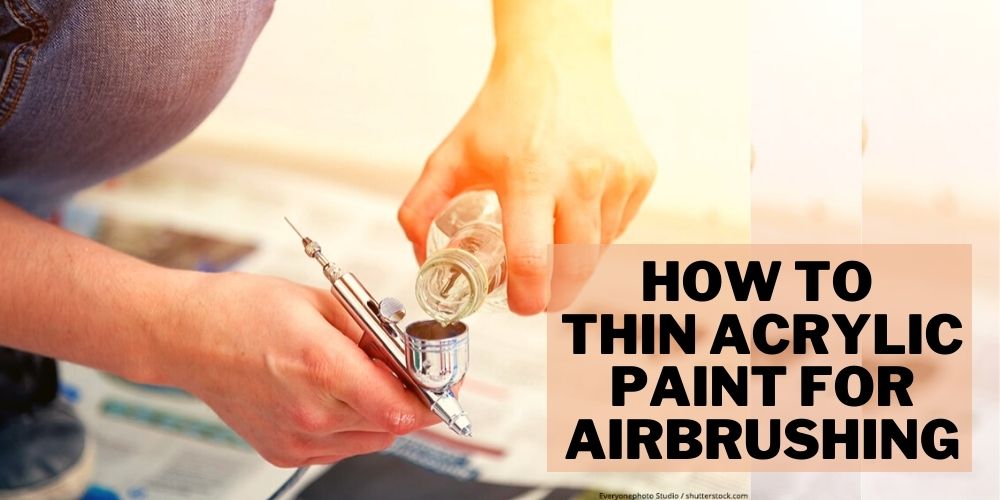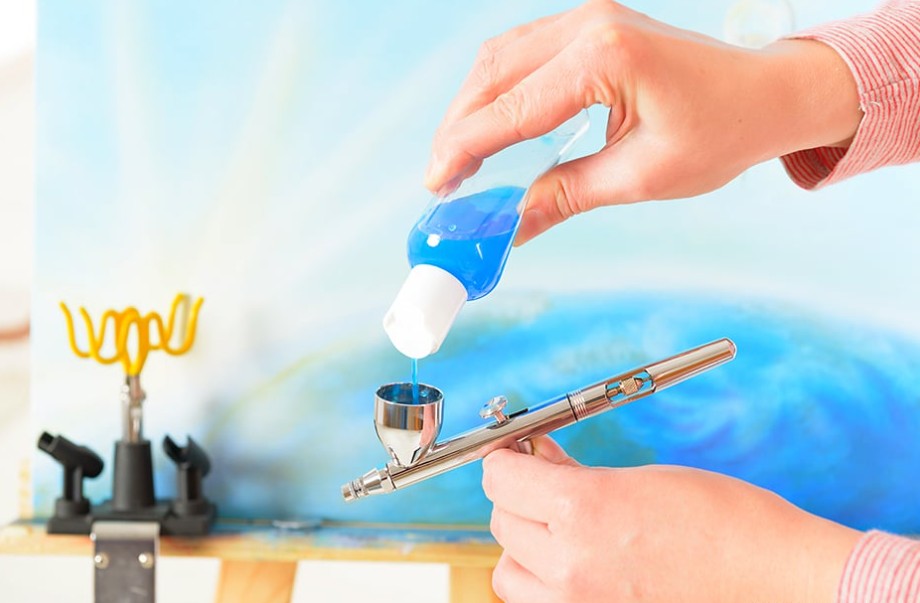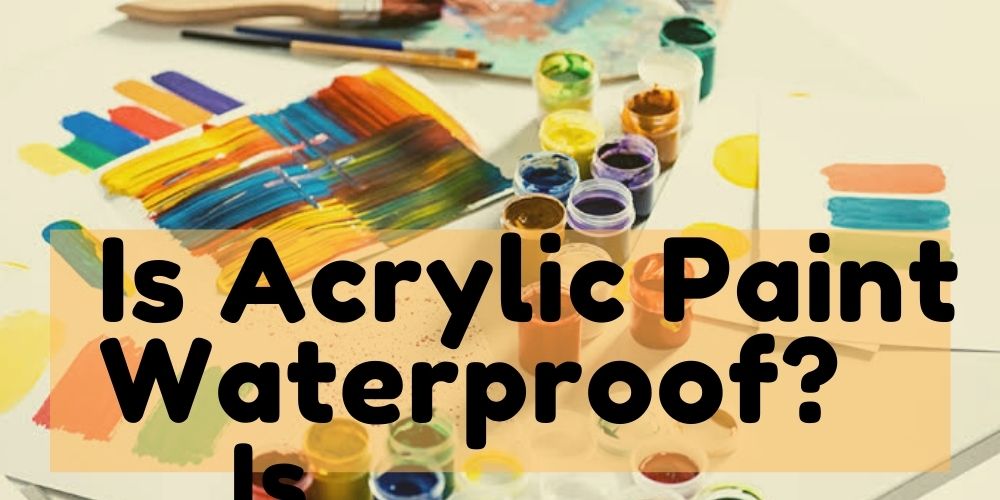Sometimes having control over a brush is not all we want. Speeding up the entire process in painting is also required. Airbrushing is a perfect way to do it, and for that, we need to thin the acrylic texture. That’s why knowing how to thin acrylic paint for airbrushing is a good practice.
Acrylic is a versatile paint, and it comes in various forms like transparent or opaque form. It is also known as one of the safest elements to use as it is water-based and does not give out toxic gas.

Using an airbrush is the quickest way to paint. To learn the art of how to thin the acrylic paint for airbrushing, you need to add some substance that assists the paint to thin out, maintaining the quality of the color. So, let us go through specific topics to know the process better.
Why thinning the acrylic paint on your airbrush is essential
Usually, many acrylic paints are labeled as ideal for airbrushing. Regardless of it being airbrush-ready, thinning the paint a bit is still necessary before applying it with ease. Thinning generally depends on many things, and it doesn’t take much time to think out how to utilize it even before its actual use in airbrushing. It’s very easy and simple.

Another important reason for thinning the paint is to maintain the consistency of the paint which is suitable for the airbrush spray. Make sure to reduce the acrylic paint paint properly otherwise the pressure in the airbrush nozzle won’t be enough to apply the paint evenly.
The fluidity of the paint will be disturbed and the paint will be released in thicker form. It entirely affects the airbrush performance.
How does the finishing of the acrylic paint affect the reducing ratio?
We already know that acrylic paint gives different finishes on different surfaces. Even various forms also play an essential part in different finishes. Opaque, candy colors, pearls, and transparency also affect the finish.
Thinning of the paint also impacts the finish on the surface. You should be aware about the ratio for reducing the paint according to your preferred artwork finishing.
For example if you want a transparent finish which easily lets the light to travel through the lacquers, you should increase the thinner portion of the ratio. It will help to make the color more vibrant.
On the other hand, opaque paints having a dense coverage don’t permit the light to pass through. So you should mix the paint and thinner ratio accordingly. These paints are more heavy and thick, contrary to other paints.
Suppose you want to give multiple coats to your surface for a better finish. It would help if you thinned the paint according to your needs.
How to thin acrylic paint for airbrushing (Guide)
For starters, distilled water and artist paint thinner (which is easily available in the market) are good options to choose for. But before moving forward, there are some factors you need to consider, for example type of airbrush, the nozzle size, the air pressure to maintain a specific consistency of the paint.

Generally, it is ideal to use a 0.5 mm nozzle in the airbrush while using thick paints. Thinning the paint too much can compromise the color pigments, and in some cases, it won’t stick on the surface.
We advise you to make sure the airbrush is working correctly before actually using it, experiment with the patterns so that you can use it quickly, and understand how much thinning it needs.
Instructions for preparing the paint
You can also apply an airbrush with metallic acrylic paint by following the same instructions stated above. Just make sure to whisk well before every application, as the metallic paint tends to quickly settle down in the bottle.
Safety measures while thinning acrylic paint for Airbrushing
Some things you need to be careful of before thinning the acrylic paint for airbrushing. Let us find out what are they.
Popular Acrylic Airbrush paint thinner to use
There are many ways to thin acrylic paint while using airbrushing. It can be manufactured thinner, water, or you can make it at home as well.
#1.Manufactured Acrylic Paint thinner – Vallejo Airbrush Thinner
If you wish to use the same type of paint as the paint, synthetic paint softeners are the best option. Model Air and Liquid acrylic paints work well with Vallejo thinner. It allows you to reduce without losing the colourants and is durable. It weighs up to 7 ounces and has a dimension of 1.88 x 1.88 x 5. 75 inches.
#2.Reducer- Createx Colors 4012 High-Performance Reducer
The main component of this reducer is water so it may be used to make a variety of paints. Because of its capacity to decrease water-based pigments, it provides the finest airbrush spray output.It is durable as you cannot just scratch it off with sandpaper. It is nonreactive, therefore, safe to use while spraying. You need to be careful while mixing and keep it in an airtight container.
#3. DIY airbrush thinner: The recipes
Recipe 1
Recipe 2
#4.Airbrush acrylic Medium
You can easily opt for Airbrush acrylic medium.This is an ideal option as you can use it individually or mix them with a reducer while applying the paint.
Golden Airbrush Medium (32 oz bottle)
It is designed for modifying The acrylic for the airbrush or spray method. It gives the acrylic a good finish and better viscosity for airbrushing. It also decreases clogging problems on the tip, which causes a lot of unfortunate events. It also reduces the heavy body, Matter, and fluorescent effects on the acrylics for spray application.
Golden Airbrush Medium ( 8 oz)
Golden-Airbrush Medium is a medium that you may use to paint. It eliminates clogging, sticking, and makes frisket work simpler. It’s great for clothes! Acrylic polymer dispersion is used to make this product. The dried film is very flexible, as well as water and UV resistant. One 8oz bottle of golden airbrush medium is included. GOLDEN airbrush colors and varnish are not compatible with this product.
Can you use water to thin acrylic paint for airbrushing?
Yes water is an ideal option to thin the acrylic paint for airbrushing purpose.
All you need to do is mix the water and paint in a 1:1 ratio. Since acrylic is a water-based product, you can use water to reduce the paint. Just make sure to use distilled water as you know tap water contains impurities. Water dilutes the binder in the color that holds the pigment and the Medium together till it dries.
How to thin solvent-based acrylic paint
Solvent-based paints are also known as oil-based or alkyd-based paints. It has a higher level of organic substance. On the other hand, due to its organic compounds, it releases toxic odors which are harmful. To thin the paints, solvent labeled paint thinner is required. This pain thinner contains mineral spirit, which helps to reduce the paint.
Frequently Asked Questions (FAQs)
Get Your Question Answer Here
Can you use an airbrush cleaner instead of a paint thinner?
Yes, you can use airbrush cleaner instead of paint thinner as thinner. Products like Vallejo airbrush cleaner are the ideal option as both cleaner and thinner. Just make sure to wear a mask and protective gear while spraying.
How thin does airbrush paint get?
The recommended thinner-to-paint ratio for airbrush applications is 1:4. It is an ideal ratio to use as a standard. However, you may need to experiment a little to get the look you desire. Although it has been proven to work with several mediums, this paint thinner is best for model air and liquid acrylic paints.
Is the airbrush thinner the same as the paint thinner?
Yes, airbrush thinner is almost the same as paint thinner. Paint manufacturers produce paint adapters mainly to make the colour more vibrant and distinct. But the paint thinner is used to light out the acrylic paint. Acrylic medium mainly helps to maintain the fluidity of the paint so that you can use it for a longer time without drying the paint on the airbrush nozzle tip.
Conclusion
Painting is a very important part of an artist’s life and sometimes making the process easier is the best option. Thinning the paint not only smoothens the painting but also helps the artists to apply the paint quickly when required.
I hope this article provided you with all the information you wanted to start your journey. Good luck!







